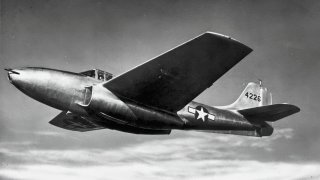Bell P-59 Airacomet: Meet America's First Jet Fighter That Failed
The Bell P-59 Airacomet, America’s first jet fighter, debuted in 1942 but didn’t see combat due to its limited speed and performance compared to WWII’s piston-engine fighters like the P-51 Mustang. Powered by two General Electric J31 engines, the P-59 reached only 413 mph, insufficient to outperform German and British jet counterparts.
What You Need to Know: The Bell P-59 Airacomet, America’s first jet fighter, debuted in 1942 but didn’t see combat due to its limited speed and performance compared to WWII’s piston-engine fighters like the P-51 Mustang. Powered by two General Electric J31 engines, the P-59 reached only 413 mph, insufficient to outperform German and British jet counterparts.
-Despite an order reduction to 66 units, the P-59 served as a crucial training platform for future jet pilots, laying groundwork for advanced U.S. jet designs like the F-80 Shooting Star.
-Today, six P-59s survive in museums, symbolizing America’s early steps into jet aviation.
Bell P-59 Airacomet: America's First Jet Fighter
Bell Textron, headquartered in Fort Worth, Texas, and its immediate predecessor, Bell Helicopter is known these days for producing rotary wing aircraft, such as the current V-22 Osprey tilt-rotor craft, and the Huey helicopter that was arguably tied with the F-4 Phantom II jet fighter as America’s most iconic warbird of the Vietnam War.
That said, yet another predecessor, the Bell Aircraft Corporation, made its fair share of historically significant fixed-wing airplanes as well. The most famous of the bunch was the rocket-powered X-1, which, on October 14, 1947, enabled the late great Chuck Yeager to become the first man to break the sound barrier.
During WWII, there were the 37 mm cannon-toting P-39 Airacobra and P-63 Kingcobra piston-engine fighter planes and there was the current subject at hand.
The first jet plane produced in the United States, say hello to the Bell P-59 Airacomet.
P-59 Airacomet Initial History & Specifications
Designed by Robert A. Wolf and Herbert L. Bower, the Bell P-59 made her maiden flight on October 1, 1942. Bell test pilot Robert Stanley was at the stick & rudder, and Colonel Laurence Craigie made the first official flight of the warbird the next day.
Mr. Stanley’s flight was technically considered a high-speed taxiing test.
For the basis of comparison, the Nazi German Luftwaffe’s Messerschmitt Me 262 Schwalbe, the world’s first operational jet fighter as well as the only jet fighter to see air-to-air combat in WWII, made her maiden flight on July 18, 1942, whilst the British Royal Air Force (RAF) Gloster Meteor, which did see combat, albeit not against manned enemy aircraft, debuted on March 5, 1943.
The warbird had the following specifications and vital stats:
Fuselage Length: thirty-eight feet and ten inches (11.84 m)
Wingspan: forty-five feet and six inches (13.87 m)
Height: twelve feet and four inches (3.76
Max Takeoff Weight: 13,700 lb (6,214 kg)
Powerplant: two General Electric (G.E.) J31-GE-5 centrifugal-flow turbojet engines, 2,000 lbs (8.9 kN) thrust each
Max Airspeed: Mach 0.53 ( 413 mph; 665 km/h; 359 kn) at 30,000 ft (9,100 m)
Service Ceiling: 46,200 feet (14,100 m)
Combat range: 375 mi (604 km, 326 nmi)
Armament:
Guns
one 37 mm M10 autocannon with forty-four rounds of ammunition
three .50 caliber AN/M2 (“Ma Deuce”) Browning heavy machine guns with 200 rounds per gun
Rockets:
eight 60-lb (27kg) rockets
Bombs:
two 1000-lb (450kg) Mark 65 general-purpose bombs
A total of sixty-six airframes were built.
Operational History
Alas, not much exciting to report here, as, unlike the aforementioned Schwalbe and Meteor, the Airacomet never saw combat. As to why this was the case, my colleague Sebastien Roblin explains, “[T]he Airacomets were never deployed operationally because their early, unreliable turbojets gave them a maximum speed of only around 410 miles per hour, slower than the P-51 Mustang piston-engine fighter then in service.”
As anybody familiar with WWII air combat knows, the P-51D was the game changer for the U.S. against the Luftwaffe in the deadly skies over Western Europe.
Thus, the U.S. Army Air Forces (USAAF, the immediate predecessor to the present-day U.S. Air Force) canceled half of the original order for 100 airframes, using the completed aircraft as trainers instead of frontline fighters.
That said, the P-59 nonetheless left behind a positive legacy, as she later generations of U.S. turbojet-powered aircraft, including the P-80/F-80 Shooting Star, a brainchild of the late great Clarence “Kelly” Johnson of Lockheed’s legendary “Skunk Works” division, which in turn did become America’s first jet fighter to see combat in general and air-to-air combat in particularly during the heady days of the Korean War.
Where Are They Now?
Out of those aforementioned sixty-six P-59 specimens built, there are six known survivors remaining today. Among them are Serial No. 44-22650, a P-59B at the National Museum of the United States Air Force at Wright-Patterson AFB near Dayton, Ohio, and Serial No. 44-22656, a P-59B at Pioneer Village in Minden, Nebraska.
About the Author
Christian D. Orr is a Senior Defense Editor for National Security Journal (NSJ). He is a former Air Force Security Forces officer, Federal law enforcement officer, and private military contractor (with assignments worked in Iraq, the United Arab Emirates, Kosovo, Japan, Germany, and the Pentagon). Chris holds a B.A. in International Relations from the University of Southern California (USC) and an M.A. in Intelligence Studies (concentration in Terrorism Studies) from American Military University (AMU). He has also been published in The Daily Torch , The Journal of Intelligence and Cyber Security, and Simple Flying. Last but not least, he is a Companion of the Order of the Naval Order of the United States (NOUS).
Image Credit: Creative Commons and/or Shutterstock.


